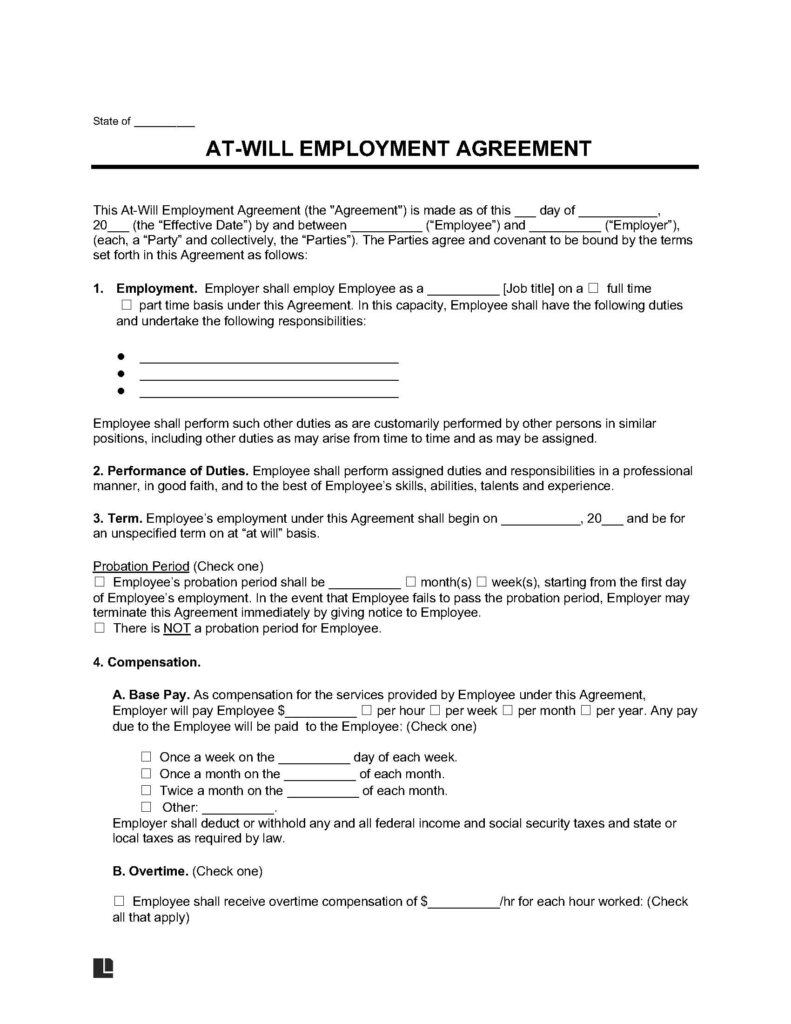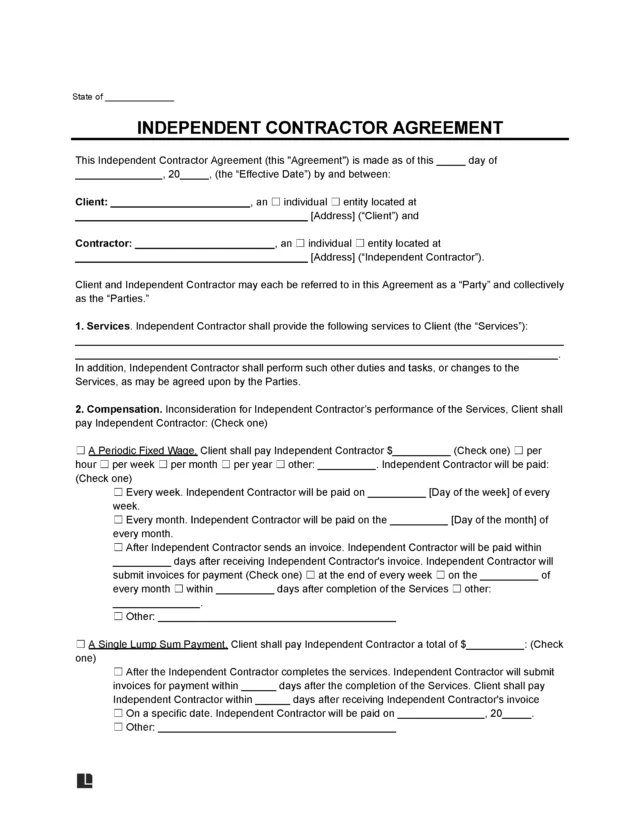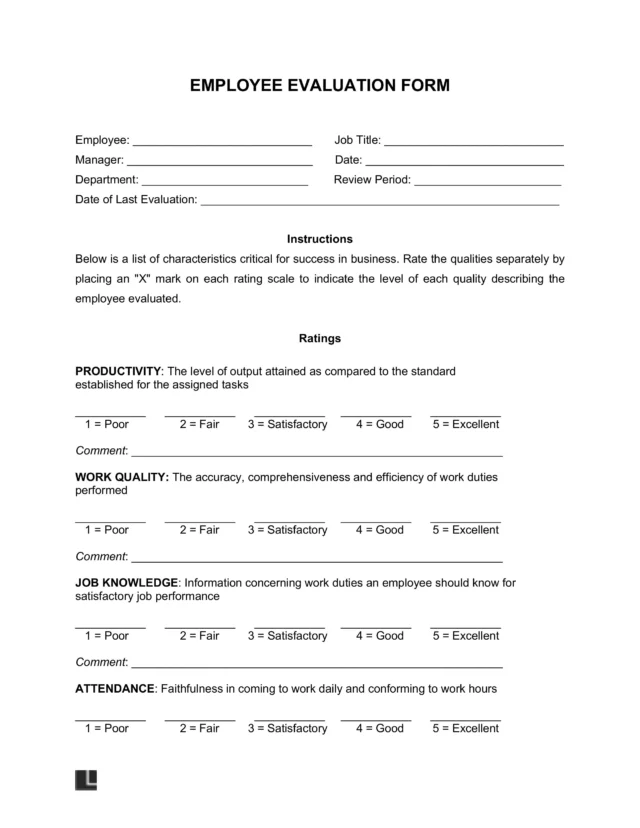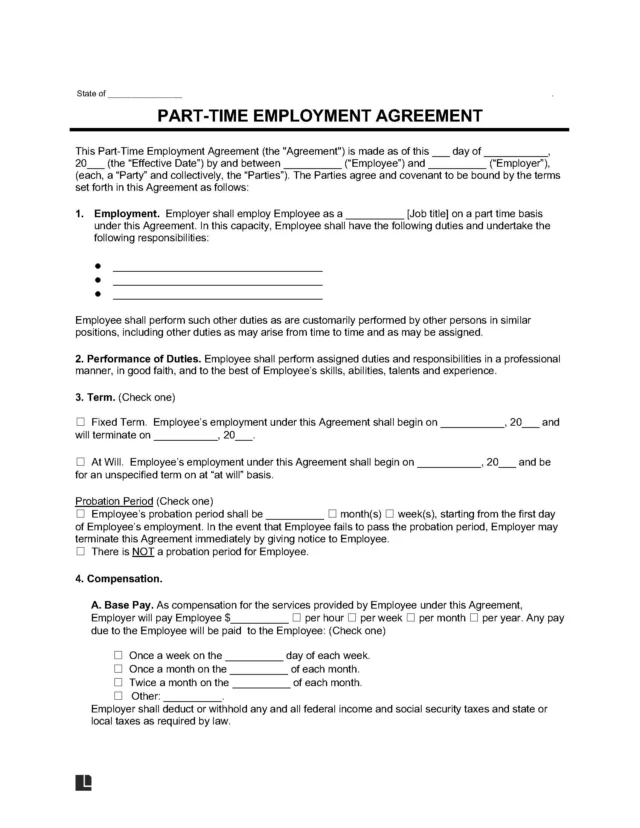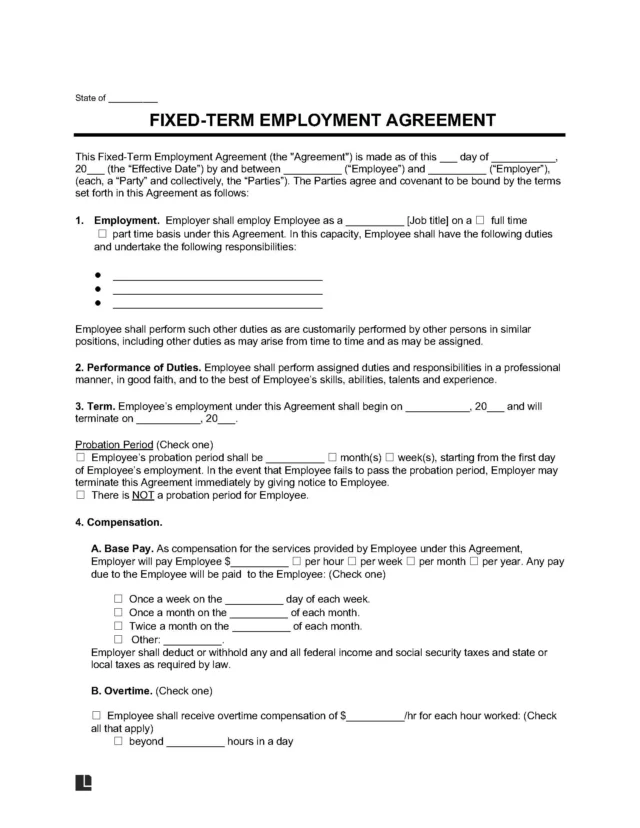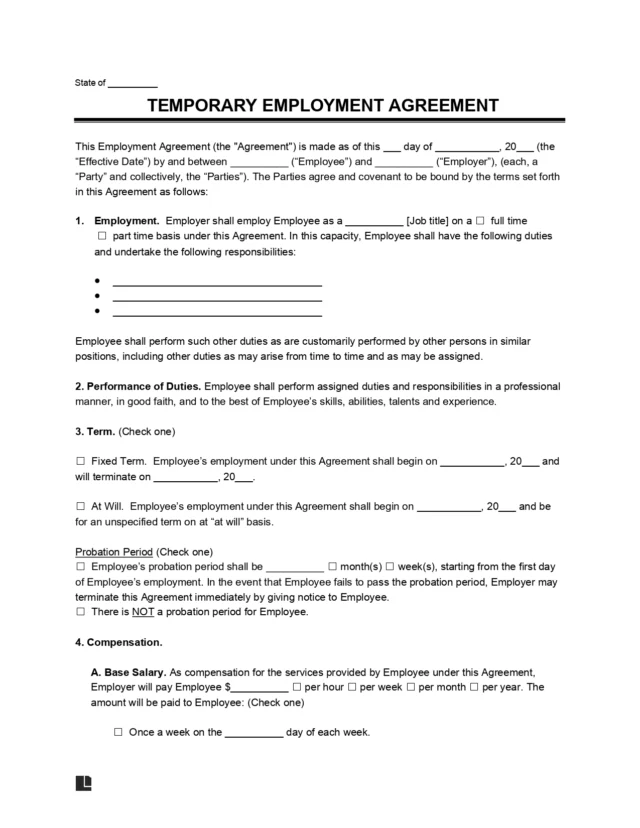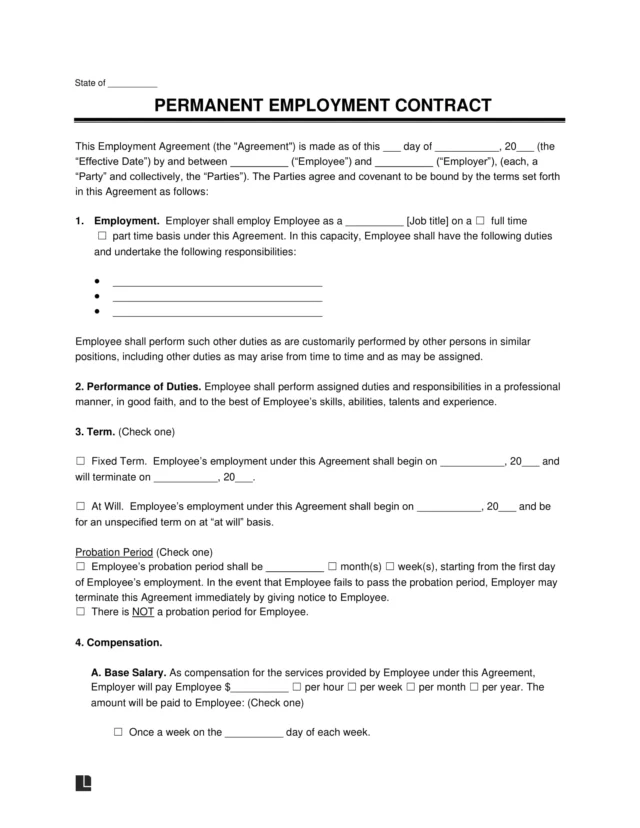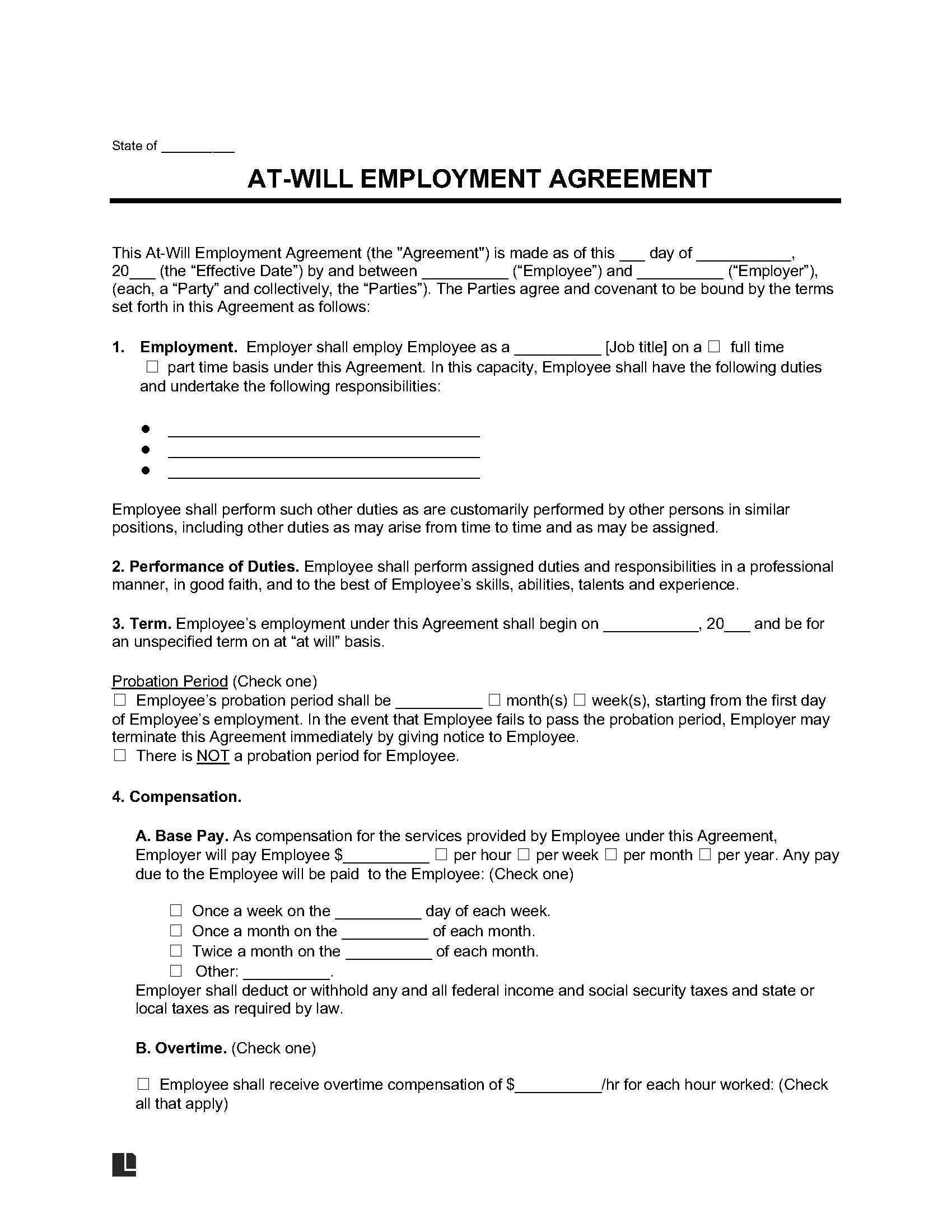What Is an At-Will Employment Contract?
An at-will employment contract is a legally binding agreement that an employee will work for an employer with no set end date. The employer or employee can terminate the agreement at any time, within the confines of the law and the terms of the contract itself.
An at-will employment contract template can streamline the contracting process and ensure you include the necessary details.
Sample At-Will Employment Contract
Use our at-will employment contract template, available in PDF and Word, to streamline your hiring process:
What Is At-Will Employment?
At-will employment means employees provide their work to the employer indefinitely. Employees may choose at-will hire instead of a contract for a fixed term if they wish to advance their careers and their employer does not have available opportunities.
An at-will agreement lets the employee depart the company when an advancement opportunity arises elsewhere.
Employers benefit from this type of employment when they need hiring flexibility but do not want a freelancer or independent contractor.
An at-will employer can hire employees when needed and let them go as necessary without risking legal consequences. However, employers can still be liable for wrongful termination if they violate federal or state employment laws.
Federal Exceptions
While both parties can terminate an at-will agreement at their discretion, certain exceptions still apply. These exceptions exist at the federal and state levels.
The following federal laws prohibit employers from firing employees due to discrimination, retaliation, or refusal to perform illegal or unsafe acts:
- Civil Rights Act of 1964, Title VII
- Civil Rights Act of 1991
- Equal Pay Act of 1963 (EPA)
- Age Discrimination in Employment Act of 1967 (ADEA)
- Americans with Disabilities Act (ADA)
- Rehabilitation Act of 1973, Sections 501 and 505
- Genetic Information Nondiscrimination Act (GINA)
Wrongful termination may also occur if the company fires someone for another person’s mistake or fails to follow established termination procedures.
State Exceptions
At-will employment exceptions vary by state. They may include the following types of exceptions:
- Public policy exceptions. These exceptions apply if an employer fires an employee for acting in accordance with public policy. For example, if an employee refuses to perform an illegal act, they cannot be fired for their refusal.
- Implied contract exceptions. When the employee and employer agree in good faith to the implied terms of an agreement, the employer cannot undermine the purpose of the contract to benefit themselves. This exception is highly subjective and depends heavily on the facts of the case.
- Implied-in-law exceptions. An at-will contract allows both parties to terminate the agreement without cause. However, if the employer indicates that the contract is for a fixed term or based on performance, they may not have grounds to terminate without cause.
States may also have laws that cover intentional interference, intentional emotional distress, retaliation, whistleblowing, and termination without good cause. If you need clarification on which laws apply to your at-will contract, consult a local employment attorney before signing.
| State | Public Policy Exemption | Covenant of Good Faith | Implied Contract Exception |
|---|---|---|---|
| Alabama | No | Yes | Yes |
| Alaska | Yes | Yes | Yes |
| Arizona | Yes | Yes | Yes |
| Arkansas | Yes | Yes | Yes |
| California | Yes | Yes | Yes |
| Colorado | Yes | Yes | Yes |
| Connecticut | Yes | Yes | Yes |
| Delaware | Yes | Yes | No |
Employee Rights in At-Will Employment Contracts
While at-will employment typically allows employers to terminate employees without cause, employees cannot be terminated for any of the following reasons:
- Age
- Race
- Gender or sexual orientation
- Pregnancy
- Disability
- Country of origin
- Citizenship status
- Religious practices or beliefs
- Genetic information
Most at-will workers also have a right to regular and overtime pay at or above the state or federal minimum wage for work performed in accordance with their contract. Check your state and local laws to determine the proper wage designation for your at-will contract.
What Should an At-Will Employment Contract Include?
An at-will employment contract should include the following information:
- Employee name
- Employer or company name
- Description of duties and responsibilities
- Work location
- Wages to be paid and payment terms
- Terms for overtime and additional compensation
- Employment start date and at-will terms
- Expense reimbursement and benefits
- Confidentiality, intellectual property rights, and proprietary information
- Termination terms
- Dispute resolution and governing laws
- Employee and employer representative signatures
Depending on the level of confidentiality your company requires, you may include an employee non-disclosure agreement in your contract paperwork. Non-disclosure agreements prevent the dissemination of trade secrets and proprietary information whose disclosure would be detrimental to the company.
How To Write an At-Will Employment Contract
Take the following steps to create an at-will employment contract:
Step 1 – Introduce the Employer and Employee
Fill in the initial statement to introduce the employer and employee. The introduction should include the names of the employer and employee and the agreement date. It should also state that both parties agree to be bound by the contract terms.
Step 2 – Specify the Employment Terms Covered by the At-Will Agreement
This section should include the duties the employee will perform under the agreement. Please indicate whether the employee works full-time or part-time and explain their responsibilities. Enter the starting date of the contract and specify that the terms are at-will.
You should also state the employee’s work location and expected hours, if applicable.
Step 3 – Outline the Payment Terms and Benefits
Indicate the employee’s compensation for their work hourly, weekly, monthly, or annually. Advise how frequently the employee will receive payment for their work, whether bi-weekly, monthly, bi-monthly, or another term. Address overtime, paid holidays, paid time off, reimbursable expenses, and other benefits.
Step 4 – Incorporate Any Additional Employment Details
Add this information to the contract if your employee will receive a commission, bonuses, or other benefits. Provide details about disability benefits, sick leave, and personal leave.
If you wish to prevent the employee from working with competitors while they are employed by you, include a non-compete clause detailing these terms.
Step 5 – Define Procedures for Confidentiality and Intellectual Property
Delineate expectations for how the employee is to handle confidential and proprietary information. Advise whether work performed by the employee on behalf of the company becomes the company’s property. Include information about legal recourse should the employee breach confidentiality or intellectual property policies.
Step 6 – Document Key Rules and Guidelines for the Working Arrangement
Outline the laws, statutes, and regulations governing your at-will agreement. Indicate which state laws apply to the contract and whether disagreements will be handled through arbitration, mediation, or litigation.
Step 7 – Allocate Space for Party Titles and Signatures
Your at-will employment agreement should include space for the employee’s full name and signature, and the employer’s full name, title, and signature. Once both parties sign the contract, it is legal and binding.


